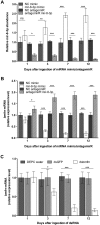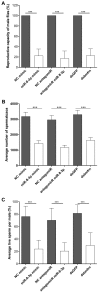miR-8-3p regulates mitoferrin in the testes of Bactrocera dorsalis to ensure normal spermatogenesis
- PMID: 26932747
- PMCID: PMC4773865
- DOI: 10.1038/srep22565
miR-8-3p regulates mitoferrin in the testes of Bactrocera dorsalis to ensure normal spermatogenesis
Abstract
Genetics-enhanced sterile insect techniques (SIT) are promising novel approaches to control Bactrocera dorsalis, the most destructive horticultural pest in East Asia and the Pacific region. To identify novel genetic agents to alter male fertility of B. dorsalis, previous studies investigated miRNA expression in testes of B. dorsalis. One miRNA, miR-8-3p was predicted to bind the 3'UTR of putative B. dorsalis mitoferrin (bmfrn). The ortholog of bmfrn in D. melanogaster is essential for male fertility. Here we show that bmfrn has all conserved amino acid residues of known mitoferrins and is most abundantly expressed in B. dorsalis testes, making miR-8-3p and mitoferrin candidates for genetics-enhanced SIT. Furthermore, using a dual-luciferase reporter system, we show in HeLa cells that miR-8-3p interacts with the 3'UTR of bmfrn. Dietary treatments of adult male flies with miR-8-3p mimic, antagomiR, or bmfrn dsRNA, altered mitoferrin expression in the testes and resulted in reduced male reproductive capacity due to reduced numbers and viability of spermatozoa. We show for the first time that a mitoferrin is regulated by a miRNA and we demonstrate miR-8-3p as well as bmfrn dsRNA to be promising novel agents that could be used for genetics-enhanced SIT.
Figures



Similar articles
-
miR-125-3p and miR-276b-3p Regulate the Spermatogenesis of Bactrocera dorsalis by Targeting the orb2 Gene.Genes (Basel). 2022 Oct 15;13(10):1861. doi: 10.3390/genes13101861. Genes (Basel). 2022. PMID: 36292746 Free PMC article.
-
Identification, characterization and target gene analysis of testicular microRNAs in the oriental fruit fly Bactrocera dorsalis.Insect Mol Biol. 2016 Feb;25(1):32-43. doi: 10.1111/imb.12196. Epub 2015 Oct 21. Insect Mol Biol. 2016. PMID: 26486729
-
Transcriptome profiling of the testis reveals genes involved in spermatogenesis and marker discovery in the oriental fruit fly, Bactrocera dorsalis.Insect Mol Biol. 2015 Feb;24(1):41-57. doi: 10.1111/imb.12134. Epub 2014 Sep 25. Insect Mol Biol. 2015. PMID: 25255964
-
miR-19b-3p induces cell proliferation and reduces heterochromatin-mediated senescence through PLZF in goat male germline stem cells.J Cell Physiol. 2018 Jun;233(6):4652-4665. doi: 10.1002/jcp.26231. Epub 2017 Nov 24. J Cell Physiol. 2018. PMID: 29171024
-
Deep sequencing of small RNA libraries reveals dynamic expression patterns of microRNAs in multiple developmental stages of Bactrocera dorsalis.Insect Mol Biol. 2014 Oct;23(5):656-67. doi: 10.1111/imb.12111. Epub 2014 Jun 23. Insect Mol Biol. 2014. PMID: 24957108
Cited by
-
RNAi-Mediated Knockdown of Tssk1 and Tektin1 Genes Impair Male Fertility in Bactrocera dorsalis.Insects. 2019 Jun 10;10(6):164. doi: 10.3390/insects10060164. Insects. 2019. PMID: 31185651 Free PMC article.
-
Identification and Characterization of MicroRNAs in Gonads of Helicoverpa armigera (Lepidoptera: Noctuidae).Insects. 2021 Aug 19;12(8):749. doi: 10.3390/insects12080749. Insects. 2021. PMID: 34442315 Free PMC article.
-
Genome-Wide Analysis of MicroRNAs in Relation to Pupariation in Oriental Fruit Fly.Front Physiol. 2019 Mar 22;10:301. doi: 10.3389/fphys.2019.00301. eCollection 2019. Front Physiol. 2019. PMID: 30967796 Free PMC article.
-
Gonadal microRNA Expression Profiles and Their Potential Role in Sex Differentiation and Gonadal Maturation of Mud Crab Scylla paramamosain.Mar Biotechnol (NY). 2019 Jun;21(3):320-334. doi: 10.1007/s10126-019-09882-1. Epub 2019 Mar 5. Mar Biotechnol (NY). 2019. PMID: 30835008
-
A genetically enhanced sterile insect technique against the fruit fly, Bactrocera dorsalis (Hendel) by feeding adult double-stranded RNAs.Sci Rep. 2017 Jun 22;7(1):4063. doi: 10.1038/s41598-017-04431-z. Sci Rep. 2017. PMID: 28642479 Free PMC article.
References
-
- Zhang H. & Li H. Photographic guide to key control techniques for citrus disease and insect pests. Beijing, Chinese Agricultural Press (2012).
-
- Agrawal A., Rajamani V., Reddy V. S., Mukherjee S. K. & Bhatnagar R. K. Transgenic plants over-expressing insect-specific microRNA acquire insecticidal activity against Helicoverpa armigera: an alternative to Bt-toxin technology. Transgenic Res. (2015). doi: 10.1007/s11248-015-9880-x. - DOI - PubMed
Publication types
MeSH terms
Substances
LinkOut - more resources
Full Text Sources
Other Literature Sources

